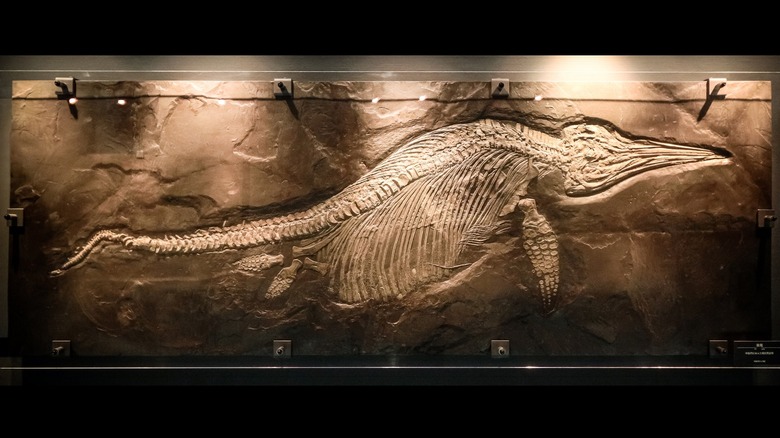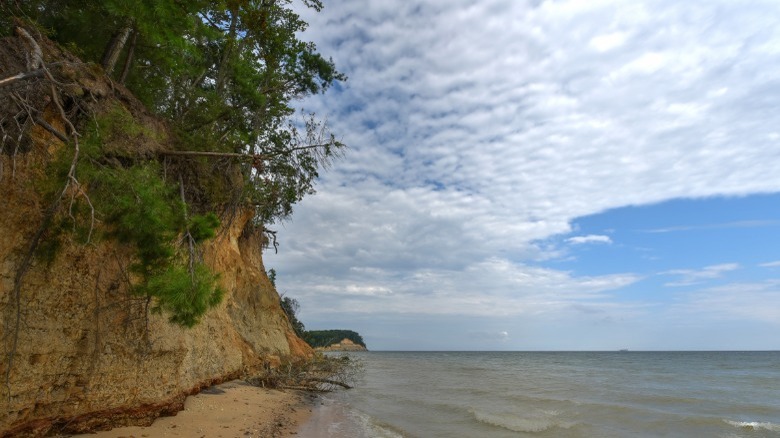The Completely Random Fossil Discovery An Expert Called The 'World Cup Of Paleontology'
What do you expect to find when you go beachcombing? Shells, of course. Seaweed. Maybe a shark's tooth if you're lucky. Probably not 12 million-year-old fossils. But that's exactly what Cody Goddard found on Matoaka Beach in Maryland in 2022. As Goddard searched for something interesting, he noticed a bit of fossil poking out of sediment along the beach. Realizing it was an unusual discovery, he immediately contacted Stephen Godfrey, curator of paleontology at the nearby Calvert Marine Museum (via All That's Interesting). According to Chesapeake Bay Magazine, Godfrey looked at the fossil via video and identified it as the skull of a prehistoric whale.
He then came down to see it in person and was able to further determine that the skull was about 12 million years old, from the Miocene epoch, which lasted from around 23 to 5.3 million years ago. The skull belonged to a species of baleen whale. Baleen whales still exist today — they eat plankton and are known for using their teeth to filter their food. However, modern baleens are much bigger than prehistoric ones. Godfrey and his team estimate the whale Goddard found would have been roughly 5.5 feet long and 18 inches wide. It could probably swim fast — and would have needed to to avoid being eaten by giant, ancient sharks called megalodons.
Next steps for the skull
Stephen Godfrey wanted to take the skull back to the museum, but that turned out to be difficult. The block of sediment surrounding it weighed 650 pounds. It took two months for a team of professional and amateur paleontologists to extract the block from its surroundings (pictured). Cody Goddard even came back to help with the process (via All That's Interesting). They then transported it to the museum via pontoon boat, according to Chesapeake Bay Magazine. It's now in the museum's Fossil Preparation Lab.
The next step — still ongoing as of January 2023 — is to remove the skull from the sediment. Museum volunteers are chipping away at it with instruments the museum itself describes as "air scribe-like tools (like miniature jackhammers)." They expect the process to take months. Though it's tedious, Godfrey said the sediment was key to the fossil's preservation, acting like a sort of sarcophagus. Once more of the skull is visible, Godfrey hopes to identify exactly what species of baleen whale this was. Museum visitors can see the skull — nicknamed Cody for its finder — on a blue hydraulic cart in the lab.
'The World Cup of Paleontology'
Matoaka Beach, where the skull was found, is part of the Calvert Cliffs area (pictured), which stretches for 30 miles down the Maryland coast, southeast of Washington, D.C. (via Visit Maryland). The area is known for its fossils — more than 600 different species of them have been discovered there. These include prehistoric sharks' teeth, sea cows, dolphins, and shellfish (via The Baltimore Sun). Chesapeake Living explains the cliffs formed 10 to 20 million years ago, encasing fossils that were already there.
According to The Baltimore Sun, as of 2010, the Calvert Marine Museum was collecting three or four prehistoric whale skeletons from the area each year. They were mostly found in the "newer" parts of the cliffs — the parts formed less than 16 million years ago. Cody Goddard's discovery was still significant, though — All That's Interesting says the skull was the most complete of its kind ever found in there. Godfrey told Calvert Marine Museum the find "felt like we had won the World Cup of Paleontology!"

